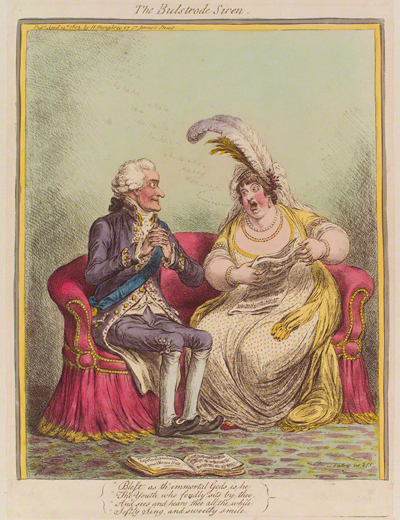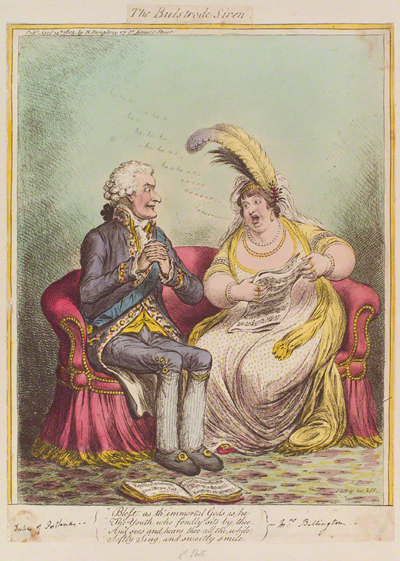The Bulstrode Siren
The Bulstrode Siren depicts the Duke of Portland sitting and listening with rapt attention to the famous opera singer, Elizabeth Billington who at the time of this print was, according to Wright and Evans, "residing with" the Duke at his mansion at Bulstrode.

© National Portrait Gallery, London
The print may have been prompted by the recent performance of Mrs. Billington at a "Grand Selection from the Most Famous Compositions of Handel, Haydn, Bach, Arne, and Purcell" on March 30th at the Theatre Royal. Or the 1803 mezzotint of Mrs. Billington as St. Cecilia by James Ward based on the 1789 painting by Sir Joshua Reynolds. Or her elevation to Prima Donna of the King's Theater, only the second English woman given that distinction. Certain it is that Mrs. Billington was always good copy. Her popularity among fans of both church and operatic music had been second to none since her triumphant return to England in 1801 after eight years abroad in Italy.
But accompanying that fame were rumors of affairs which began with a clearly scurrilous publication of The Memoirs of Mrs. Billington in 1792 which claimed to be based on reliable sources and supposedly detailed affairs she had while still married to Mr. Billington. In that Memoir, Mrs. Billington is often referred to as a "syren" so it is possible that Gillray either read or heard enough about the book to be inclined to think her presence at Bulstrode was more than simple residence. In 1803, Mrs. Billington had been estranged from her second husband for several years, and the Duke had been a widower since 1794.
The book of music at their feet is entitled "Epithalamium pour l'Heureux Nuit" suggesting perhaps that after the siren song, there is a wedding-like consummation in store for the Duke. And the subtitle of the print is a quotation from the love poetess, Sappho, translated by Ambrose Phillips.
Blest as the immortal gods is he,
The youth who fondly sits by thee,
And hears and sees thee all the while
Softly speak, and sweetly smile.
But siren songs do not usually end well for the listener. And the last verse of Sappho's poem includes these perhaps ominous lines:
In dewy damps my limbs were chilled;
My blood with gentle horrors thrilled:
My feeble pulse forgot to play
I fainted, sunk, and died away.
There are two slightly different versions of this print extant, both seemingly published on the same day. They differ in the Duke's profile and expression and perhaps most obviously in his legs and feet. The second version (which appears to have been the last issued, since more copies seem to be available) gives the Duke thicker and perhaps gouty legs. If so, Gillray may have been misinformed. The 2nd Duke of Portland suffered from the gout, and indeed had a supposed remedy, Portland Powders, named for him. But by 1801 the third Duke (according to the Monthly Magazine and British Register) published that year was supposedly gout free, owing
"his amendment, and indeed his recovery from this painful complaint, to a meritorious and steady adherence to an abstemious and regular course of diet, which consists nearly of vegetable substances; the mixture of animal food being very small, and that of the mildest kind. To this is joined a total abstinence from all fermented liqors, and it is to this judicious management. . . that he ascribes his freedom from this hereditary malady.

© National Portrait Gallery, London
Sources and Reading
- Commentary from the British Museum on The Bulstrode Siren
- "Mrs. Elizabeth Billington," A Dictionary of Music and Musicians:Wikisource
- "Memoir of Mrs. Billington," The Harmonicon, Volume 8
- "Elizabeth Billington," Yodelout!Music
- "What a Nineteenth-Century English Soprano Can Teach Us About the Income Gap," Penguin Press
- Thomas Wright and R.H. Evans, Historical and Descriptive Account of the Caricatures of James Gillray #526
Comments & Corrections
NOTE: Comments and/or corrections are always appreciated. To make that easier, I have included a form below that you can use. I promise never to share any of the info provided without your express permission.